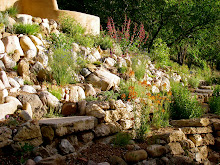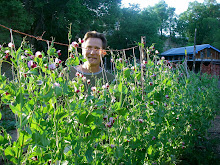I am no expert on fruit tree care, but local nurseryman Gordon Tooley of Tooley's Trees is. I attended a very good workshop he gave a couple of years ago in early March on pruning, and I thought my photos from that day would provide some useful illustrations for a winter task which many find confusing.
In this shot we see a young tree, probably about three years old. It has already been pruned the year before for shape. Take note of the angle of the branches; they spread out from the trunk with a wide angle. Just three or four well-spaced main branches is desirable. However, the water sprouts from the base of the tree must be removed.

Gordon held onto every little branch he cut, rather than dropping them on the ground. Between trees he sprayed his pruners with a bleach solution he carried in a spray bottle. All this was for disease prevention. The pruned branches could be used for grafting if one was that ambitious.
He pruned to open up the interior of the tree, and to eliminate crossed branches. As a rule of thumb, there should be room for a bird to be able to fly through a fruit tree without brushing its wings on the branches. Fewer branches means that the tree sends more energy to the fruit, so it gets bigger. It also means better air circulation for disease resistance, and facilitates harvesting.

Where three branches emerged from one point he has cut one out to leave the two which were the best placed. Note that the cut is near the trunk. A well done cut like this is placed barely outside of the ring at the base of the branch. This ring, if left intact, will continue to grow, allowing the tree to seal the cut over time. He also removes branches growing at too tight an angle, which would result in a weak joint that could later break under the weight of the fruit.

Here's an example of a poorly done cut from the year before. It was made too far from the trunk, and the bark peeled away as well. These flaws are the result of hurried, careless work, or a lack of knowledge. Such mistakes can open the tree up to disease. A cut like this can lead to heart rot and shorten the life of the tree. Look for the "dotted line" that shows you where to make your cut.

Here's a well-established orchard which had been neglected for many years. The trees have become overgrown and are now producing undersized fruit. They need thinning to return to productivity.

Originally this tree was pruned properly, and has a nice shape, but it needs a good thinning to restore it. A bird would have a tough time flying through that tangle! A stricter standard calls for being able to throw a cat through the branches...must've been a cat-hater that came up with that one!

Here you can see water sprouts which were allowed to grow. Obviously, even if you wanted to keep some to fill in a hole, there are too many for the tree to support. Suckers like these can rob the older well-placed branches of water and nutrients, and will eventually take over.
Timing is important for pruning. Late winter is a good time, as disease organisms are dormant and not liable to get into the cuts. The lack of leaves makes the branch structure obvious, and eases the entire process. However, winter pruning does cause sucker growth.
One of Mrs. B's favorite quotes from one of the English garden writers she loves (sorry I've forgotten which one) is "growth follows the knife". It's quite true. Whenever you prune you are liable to stimulate a reaction in the tree to produce more vegetation. This is a survival mechanism, to tolerate browsing by herbivores. It hasn't been long since trees had BIG herbivores with which to coexist and coevolve (giant ground sloths...think about it!). But if we prune we need to continue maintaining the trees to optimize their form for production.
 I am no expert on fruit tree care, but local nurseryman Gordon Tooley of Tooley's Trees is. I attended a very good workshop he gave a couple of years ago in early March on pruning, and I thought my photos from that day would provide some useful illustrations for a winter task which many find confusing.
I am no expert on fruit tree care, but local nurseryman Gordon Tooley of Tooley's Trees is. I attended a very good workshop he gave a couple of years ago in early March on pruning, and I thought my photos from that day would provide some useful illustrations for a winter task which many find confusing.  Gordon held onto every little branch he cut, rather than dropping them on the ground. Between trees he sprayed his pruners with a bleach solution he carried in a spray bottle. All this was for disease prevention. The pruned branches could be used for grafting if one was that ambitious.
Gordon held onto every little branch he cut, rather than dropping them on the ground. Between trees he sprayed his pruners with a bleach solution he carried in a spray bottle. All this was for disease prevention. The pruned branches could be used for grafting if one was that ambitious.  Where three branches emerged from one point he has cut one out to leave the two which were the best placed. Note that the cut is near the trunk. A well done cut like this is placed barely outside of the ring at the base of the branch. This ring, if left intact, will continue to grow, allowing the tree to seal the cut over time. He also removes branches growing at too tight an angle, which would result in a weak joint that could later break under the weight of the fruit.
Where three branches emerged from one point he has cut one out to leave the two which were the best placed. Note that the cut is near the trunk. A well done cut like this is placed barely outside of the ring at the base of the branch. This ring, if left intact, will continue to grow, allowing the tree to seal the cut over time. He also removes branches growing at too tight an angle, which would result in a weak joint that could later break under the weight of the fruit. Here's an example of a poorly done cut from the year before. It was made too far from the trunk, and the bark peeled away as well. These flaws are the result of hurried, careless work, or a lack of knowledge. Such mistakes can open the tree up to disease. A cut like this can lead to heart rot and shorten the life of the tree. Look for the "dotted line" that shows you where to make your cut.
Here's an example of a poorly done cut from the year before. It was made too far from the trunk, and the bark peeled away as well. These flaws are the result of hurried, careless work, or a lack of knowledge. Such mistakes can open the tree up to disease. A cut like this can lead to heart rot and shorten the life of the tree. Look for the "dotted line" that shows you where to make your cut. Here's a well-established orchard which had been neglected for many years. The trees have become overgrown and are now producing undersized fruit. They need thinning to return to productivity.
Here's a well-established orchard which had been neglected for many years. The trees have become overgrown and are now producing undersized fruit. They need thinning to return to productivity. Originally this tree was pruned properly, and has a nice shape, but it needs a good thinning to restore it. A bird would have a tough time flying through that tangle! A stricter standard calls for being able to throw a cat through the branches...must've been a cat-hater that came up with that one!
Originally this tree was pruned properly, and has a nice shape, but it needs a good thinning to restore it. A bird would have a tough time flying through that tangle! A stricter standard calls for being able to throw a cat through the branches...must've been a cat-hater that came up with that one! Here you can see water sprouts which were allowed to grow. Obviously, even if you wanted to keep some to fill in a hole, there are too many for the tree to support. Suckers like these can rob the older well-placed branches of water and nutrients, and will eventually take over.
Here you can see water sprouts which were allowed to grow. Obviously, even if you wanted to keep some to fill in a hole, there are too many for the tree to support. Suckers like these can rob the older well-placed branches of water and nutrients, and will eventually take over. 









No comments:
Post a Comment